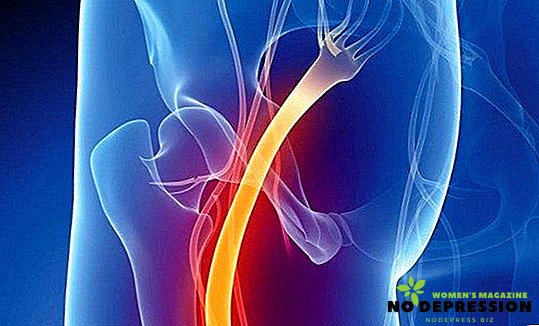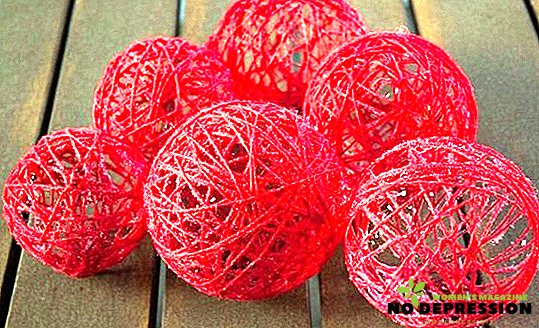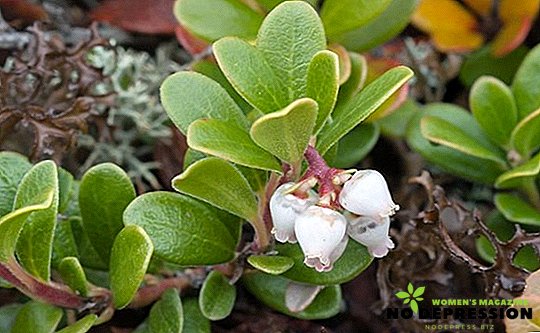Pinching or pinching the sciatic nerve, as well as lumbosacral radiculitis with pinching of the roots of the sacral section, is one and the same disease, in which pain is localized in the lumbar region, thigh, lower leg, foot, aggravated by coughing, walking.

The main causes of this pathology
Pinching or pinching of the sciatic nerve can occur for the following reasons:
- the presence of intervertebral hernia;
- spinal cord injuries or bruises with displaced vertebrae;
- osteochondrosis in the lumbar or sacral regions;
- excessive loads;
- inflammatory processes in organs that are located in the pelvis;
- abscesses in the sciatic nerve;
- infectious bone diseases;
- the formation of blood clots in the vessels;
- exposure to cold in the lumbar region;
- muscle inflammation.
Pregnancy can also lead to this disease: when the fetus is enlarged, the uterus squeezes the rest of the organs, tissues, which leads to the pinching of the nervous column.
In addition to the main factors affecting the sciatic nerve, there are some risk factors that can also cause pathology. These include:
- excess weight;
- lack of minerals;
- poisoning with heavy metal salts;
- herpes zoster.
Signs of inflammation - what to look for?
Sciatic nerves - the largest and longest nerves in the human body. They pass to the left and right of the waist towards the legs. In the inflammatory process, the patient may be disturbed by pain in one of the nerves, localized in the thighs, buttocks, may reach the feet. In the case of pinching pain, according to the patient, is characterized as burning, cutting, sharp. May occur suddenly in acute pathology, in chronic - occur with periodic relapses.
 Most often, an attack of pain begins after hypothermia, emotional overstrain, usually begins closer to the night.
Most often, an attack of pain begins after hypothermia, emotional overstrain, usually begins closer to the night.
In the course of the nerve, the sensitivity of the skin is disturbed, or intensified when tingling appears. First, the discomfort extends to the back of the thigh, descends to the foot through the lower leg. The pain can be of such strength that a person faints. At the same time, vegetative problems are observed: the sweating of the feet increases, the skin reddens and swells.
During attacks of pain a person has to take a forced position of the body, rely on a healthy limb. In this case, one of the signs of this disease is a modified gait.
In the case of a severe inflammatory process, a decrease or complete disruption of the nerve may be observed. In this case, the gluteus or gastrocnemius muscles may decrease, which is why the patient cannot bend the lower leg, and there are irregularities in flexing the fingers.
How is the diagnosis?
Before prescribing treatment, the doctor needs to find out the cause of the pain. One cannot do without qualitative diagnostics, since sciatica is a disease in which various symptoms can be observed.
For this reason, you should visit a neurologist, who will conduct an external examination, check reflexes, which will allow to estimate the degree of the disease. Next, you will need to take an x-ray or MRI (in difficult cases).
If a malignant or benign tumor is suspected, a patient can be sent to conduct a radioisotope spinal scan.
It is necessary to promptly seek medical help in the following cases:
- temperature rise up to +38 degrees;
- strong edema appears on the back;
- pain spreads through new areas of the body;
- when urinating, a burning sensation appears, problems with urination may occur.
Features of the treatment of this disease
Therapy of this disease is required to be entrusted to a qualified specialist who will prescribe treatment according to the results of diagnostics.
Physiotherapy
This method helps patients to reduce pain by an order of magnitude, but it does not eliminate the main reason. Doctors most often prescribe:
- electrophoresis;
- UHF-therapy;
- laser therapy;
- paraffin baths;
- electrosleep.
These activities will help improve blood circulation, eliminate swelling, so that the pain gradually goes away.
Massages, reflexology
After the acute inflammatory process subsides, it is useful to conduct a general or canned massage, register for acupressure and acupuncture sessions. Even holding events with the use of a Kuznetsov applicator can help relieve discomfort by removing tension from a muscle. Any sessions of massage therapy will help speed up the lymphatic flow, reduce pain, restore nerve function.

Drug therapy
With this disease, it is usually prescribed anti-inflammatory and anesthetic drug therapy. The most effective drugs are NSAIDs. Among them note the following:
- Diclofenac;
- Indomethacin;
- Ibuprofen;
- Ortofe;
- Ceberex;
- Sulindak;
- Naproxen;
- Ketorolac.
These funds are irritating to the gastric mucosa, affect the work of the kidneys, blood clotting. It is for this reason that they should be prescribed only by a doctor on the basis of a diagnosis.
There are drugs that are safer for health: Movalis, Arcoxia, Nimesulide. True, they are taken for a longer period.
In case of an increase in pain, steroid hormonal preparations may be prescribed in a small course. They relieve pain, but they cannot eliminate the cause of the inflammatory process. Their use also has many side effects, contraindications.

Additionally, you can prescribe vitamin and mineral complexes, drugs, to improve metabolic processes, accelerate blood circulation, to relax the muscles. Among them note the most effective:
- Mydocalm;
- Tizalud;
- Baclofen;
- Neurobion;
- Milgamma;
- Combilipene;
- Trigamma;
- Neurovitan.
Physiotherapy
Even the simplest and easiest exercises, for example, “bicycle”, Nordic walking, light stretching - will be incredibly effective at pinching the sciatic nerve.
Spa treatment
During remission, spa treatment is indicated. The most therapeutic techniques: mud therapy, hydrotherapy, pearl baths, underwater stretching sessions.
It should be noted that such therapy not only relieves the inflammatory process, but also strengthens the immune system, reduces the number of colds.

What should be the mode in the acute phase?
In this case, it is necessary to observe bed restraint (it is desirable that the mattress be rigid), limiting any physical activity until the end of the inflammatory process. Moreover, in this period it is better not to self-medicate, but to call a specialist to the house.
Treatment of the sciatic nerve folk remedies
Therapy of this disease is a long process. Before using any folk remedies and methods, it is necessary to consult a specialist in order not to harm your body even more.
You can use warming compresses. To do this, scroll through the meat grinder peeled horseradish, add to the same 1 grated raw potato and 1 tbsp. honey Thoroughly mix the whole mass, transfer this mass to a clean gauze, wrap it, put it on its back, cover it with polyethylene on top, attach a warm blanket. During treatment for an hour you can not get up. The skin will burn, but should not be afraid. Put compresses every 2-3 days.

Compresses with fir oil can also be used for treatment at home. Soak a clean piece of cloth with the liquid, apply it to the lower back, cover it with cellophane from above, put the heating pad on top. It is very important to lubricate the skin with a small amount of vegetable oil to avoid the appearance of a burn. Keep a compress about 1 hour.
Some recommend making compresses from rye flour: knead the dough, apply on gauze in several layers and place on a sore spot. Put a compress every night for 10 days.
Herbal balm, which is prepared from the following components (1 tbsp), is also suitable:
- celandine;
- aloe leaves;
- crushed bitter pepper.
Additionally required 500 ml of vodka. All components are mixed, infused for 10 days, then rubbed into the affected area.
Good results are shown bath with a decoction, which must be prepared from 50 g of the roots of the forest angelica and 500 ml of boiling water infused for two hours. Bath take daily for 15 days. You can also make baths with the addition of dry chamomile or sage.
Also, many advise to use infusions and decoction for oral administration. The most effective means:
- 2 tbsp. calendula flowers pour 400 ml of boiling water, infused for two hours. Accept such broth on 100 ml before food.
- 1 tbsp. chopped burdock root pour 200 ml of red wine, boil for 5-10 minutes. Take 100 ml twice a day.
- 2 tsp. horse chestnut seed poured 400 ml of boiling water, steamed in a water bath for half an hour. After filtration, take before each meal 100 ml.
- 1 tbsp. Elecampane root is brewed in 200 ml of boiling water, boiled for 25 minutes. This decoction is particularly effective in the treatment of chronic forms of the disease: twice a day, 30 minutes before meals.
There is another popular recipe for herbal decoction. Looking for the following ingredients:
- 1.5 tbsp. flower of calendula, viburnum, thyme;
- 3 tbsp. horsetail
Mix all ingredients, put 2 tbsp into an enamel saucepan. mixture, pour 400 ml boiling water, put on fire. After a couple of minutes, turn off the stove and leave the broth to infuse for 20 minutes. Take a drink in the form of heat 100 ml three times a day before meals.












